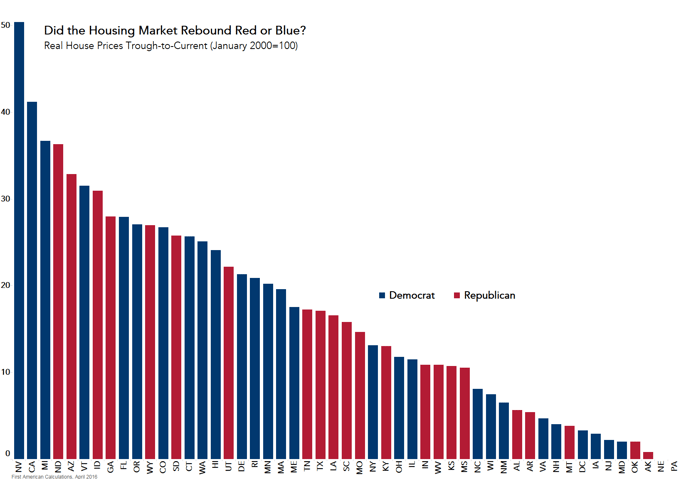With the national conventions for the major political parties upon us and the presidential election just a few months away, talk of red versus blue states frequently bubbles up in the media and at the water cooler. Cutting-edge statistical analysis is regularly updated to keep up with the fast changing dynamics of the country’s political leanings.
When you look at the political leanings of each state across the U.S., there is a striking geographic pattern drawn across party lines, with democratic leaning states predominantly in the West, upper Midwest, and Northeast and Republican leaning states in the South and center of the country. We can’t help but wonder whether the states may diverge in other ways than just political. Since we love real estate and talking about real house prices, we considered the following question – How have “blue” states and “red” states performed in the housing recovery?
“So, did the housing market rebound red or blue? Blue, but the rebound is driven by the geographically differentiated depth of the crisis.”
The old adage that real estate is local still applies. House price trends vary widely by location. A quick recovery in New York can coincide with a flat recovery or even a decline in Detroit. It’s not the geographic region itself that causes differences in real estate markets. House price trends are driven by a variety of conditions that can differ dramatically across different markets. The local economy, the types of jobs that the local economy supports, education levels, the supply of housing, regulations and zoning laws, and demographics all can influence house prices.
So, if we use real house prices as a proxy for all of the underlying conditions that drive them, who has fared better? We have the perfect tool to help answer this question. First American’s Real House Price Index (RHPI) is a measure of both consumer house-buying power and housing affordability – showing the price changes of single-family properties throughout the U.S. and adjusting for the impact of income and interest rate changes on consumer house-buying power over time. Shifts in income and interest rates either increase or decrease consumer house-buying power or affordability. When incomes rise and/or mortgage rates fall, consumer house-buying power increases. The RHPI is set to equal 100 in January 2000. So, a state with an RHPI value of 110 in 2016 has seen real house prices increase 10 percent since 2000.
Using the RHPI, housing recovery is measured by calculating a state’s current RHPI as a percent from its trough or low point. Using the most current political “red versus blue state” prediction to group the states together, we find that there is a 4 percent difference in the overall housing recovery among all states, with the blue states having recovered 20 percent (on average) from their trough values, and the red states having recovered 16 percent.
The figure below shows that among the Democrat-leaning blue states, Nevada, California, and Michigan produced the highest overall recovery. Among the Republican-leaning red states, North Dakota, Arizona, and Idaho come in at the top.

The good news here is that all states, with the exception of Hawaii, are still well below their 2000 real house price levels. Given current interest rates and income levels, housing consistently remains more affordable than it was in 2000. Also, there are no states with real house prices that are currently below their historical trough values, so there is widespread house price recovery across the country.
Here’s the rub. The analysis has nothing to do with the impact of any differences in housing policy across these states. The relative housing market performance among red and blue states is partly reflecting the high concentration of Democrat-leaning blue states along the coast and corresponding higher house prices and more dramatic price swings, and the concentration of Republican-leaning red states in the more affordable American heartland, where house prices are less volatile. This explains the faster recovery of blue states versus red states because the harder hit markets along the coasts have had the strongest recoveries.
So, did the housing market rebound red or blue? Blue, but the rebound is driven by the geographically differentiated depth of the crisis.
Odeta Kushi contributed to this blog post.



